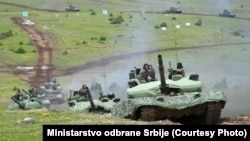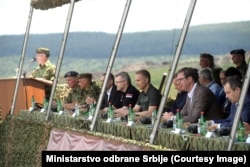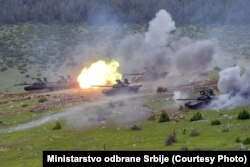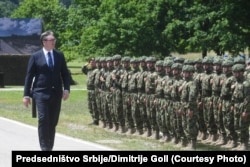BELGRADE -- By land and by air.
From the Peshterska Plateau in the southwest to a historic Serbian capital farther north.
With tanks, heavy weapons, and drones to go along with around 2,300 troops.
Serbia's army and air force this month put on a display of military might and diplomatic clout in two weeks of exercises, dubbed Lightning Strike, that marked the seventh such tactical drills so far this year.
The inclusion of Russian MiGs and T-72 tanks, Airbus light-attack helicopters, and Chinese combat drones appeared to underscore populist President Aleksandar Vucic's avowal of a "multi-vector" foreign policy that has frequently rankled the West.
But there was also something for Vucic's domestic audience one day after the exercises wrapped up on June 27, as some of the troops and hardware were transported about 200 kilometers north for a show for the public near a World War II memorial in the first modern Serbian capital, Kragujevac.
June 28 is a national holiday in Serbia to mark the 14th-century Battle of Kosovo, a source of pride for many Serbs and a reminder of perceived indignities since the breakup of Yugoslavia in the early 1990s, including Kosovo's partially recognized independence.
The carefully orchestrated appeal to Serbian nationalism was lent greater force by a pledge from Vucic, who told the crowd in Kragujevac that even more military equipment is on the way.
"We'll get a lot next year, which will make the Serbian Army twice as strong as today," Vucic said.
It marked a sharp contrast with his statements 18 months ago, when he signaled a brake on major purchases in order to "modernize the army."
"We will adopt additional reforms of our army, to make it even more mobile and faster," Vucic said in December 2019. "That doesn't mean buying weapons -- on the contrary."
Vucic -- who has maintained a policy of seeking EU membership and keeping a strategic relationship with Moscow, while bucking most of the region's trend of pursuing NATO membership -- stressed that Serbia is "not interested in any wars or conflicts."
Belgrade, he said, is merely "strengthening the army for defense" of the country.
But a turn toward greater militarization could unsettle some of Serbia's neighbors, which include not only a partly recognized Kosovo and a shambolic and ethnically divided Bosnia-Herzegovina, but also EU member Croatia, whose officials demanded an apology earlier this year after a member of a Serbian delegation described one of its Adriatic towns as "Serbian and occupied."
Serbia has around 7 million people and also boasts the biggest economy among non-EU members in the Western Balkans, with strong trade ties in the former Yugoslavia and robust trade with EU members like Germany and Italy.
Checking Out Capabilities
Defense Minister Nebojsa Stevanovic said Lightning Strike was simply "an excellent opportunity to check the operational capabilities of the command and units of the Serbian Army."
"It also showed how much was invested in equipping and arming our people," he said.
But with the horrors of war and ethnic cleansing so fresh in people's minds and reconciliation proceeding so slowly since the Balkan wars of the 1990s, many people are bound to be concerned at a perceived buildup anywhere in the region.
"Anytime that Serbia is parading military equipment, this is always something that will make a lot of people very nervous, given the past," James Ker-Lindsay, a visiting professor at the London School of Economics and Political Science, told RFE/RL's Balkan Service.
It is clear that "things have moved on," he said, but Belgrade still has its critics.
"It's a very good opportunity for people in other countries who don't view Serbia in a particularly positive light to then use this as a chance to point the finger and say, 'Look, they haven't changed, they're still as militaristic as they were in the past. This is all about trying to flex their muscles and show their neighbors that they're still able to take back territory, and that's what they want.'"
Ker-Lindsay said the "natural inclination" would be to regard any Serbian buildup as being directed at Bosnia-Herzegovina or Kosovo, both with sizable Serb minorities.
"[But] in reality, what has been driving a lot of the [Serbian] defense expenditure in recent years -- and is actually more worrying in many ways -- is the relationship with neighboring Croatia," Ker-Lindsay said.
Serbia overtook NATO member Croatia as the region's biggest military spender in 2019, according to the Stockholm International Peace Research Institute (SIPRI). That ranking was fueled by a 43 percent year-on-year hike in defense spending.
Russia, in particular, has sold air defenses like the Pantsir system and other military hardware to Belgrade, while China has supplied unmanned aerial vehicles (UAVs) like the CN92-A combat drones used in Lightning Strike.
To some Westerners, then, Serbia parading military equipment might not be a good look.
"I think it's worrying because this doesn't do a lot of good for Serbia's international standing," Ker-Lindsay said. "And there's also a bit of a view -- certainly not in all EU member states but in a number of them -- that military parades are a bit passé."
But he also said that many countries have been eager to sell military equipment to both countries, citing France as an example.
That could highlight "a bigger reason behind it that in some ways is potentially more worrying," he said.
Militaristic Populism?
Blagoje Grahovac, a geopolitical analyst and retired general from Montenegro, said he thinks the recent military showboating by Serbia is more likely an appeal to populism that is directed at Serbia's own public rather than other countries.
"It's populism in order to militarize the state of mind of the citizens," Grahovic told RFE/RL's Balkan Service. "What can it serve? Unreasonable policies to once again abuse citizens."
He warned against the "wrong path" in Belgrade of basing its defenses so heavily on weaponry, rather than "friendly relations with its neighbors."
But he is not necessarily fearful of a major conflict, he said.
"Who can wage war in the Balkans today? Nobody," Grahovac said. "If someone goes to war, they'll lose. Neither the European Union nor the international community will allow it."
The most reliable estimates are that at least 130,000 people died during the so-called war of Yugoslav succession that erupted as that country disintegrated in the 1990s, and millions more were displaced.
Plenty of Serbia's citizens are weary -- and wary -- of military solutions.
One day before the big display of military weaponry at Kragujevac that was attended by Vucic, a group of locals -- including activists in the Serbian opposition -- laid flowers at the Sumarica memorial to the nearly 3,000 civilians who were executed by Nazi forces there in 1941.
They called it a symbolic "apology" that was part of a broader anti-war message to counter the government's public militarism.
"Are we now threatening someone again? Are we demonstrating force for internal political reasons? Or what's the reason?" asked Ljiljiana Palibrk, one of the organizers of the peace gesture. Whatever it is, she said, "the choice of location is inappropriate."
With much of the public's focus on ending an unprecedented health crisis and fostering economic recovery, Vucic's Progressive Party (SNS) used its supermajority in the Serbian parliament in April to allocate an additional 40 percent, beyond what lawmakers had originally proposed, for defense spending (to about 1.2 billion euros or $1.45 billion).
Maja Bjelos, a researcher for the Belgrade Center for Security Policy (BCSP), an NGO, suggested the "the goal of this exercise, this play, was mostly directed toward domestic public opinion" to rally Serbian public support for such heightened military funding.
"The army is strong if it has people who know how to handle equipment, especially if we're talking about equipment that was procured either from Russia or China, if it is professional and depoliticized -- that is, it is not instrumentalized by politicians and political parties," he said. "On the other hand, the priorities of the citizens of Serbia are to have clean water and clean air, better health, [and] higher employment."















